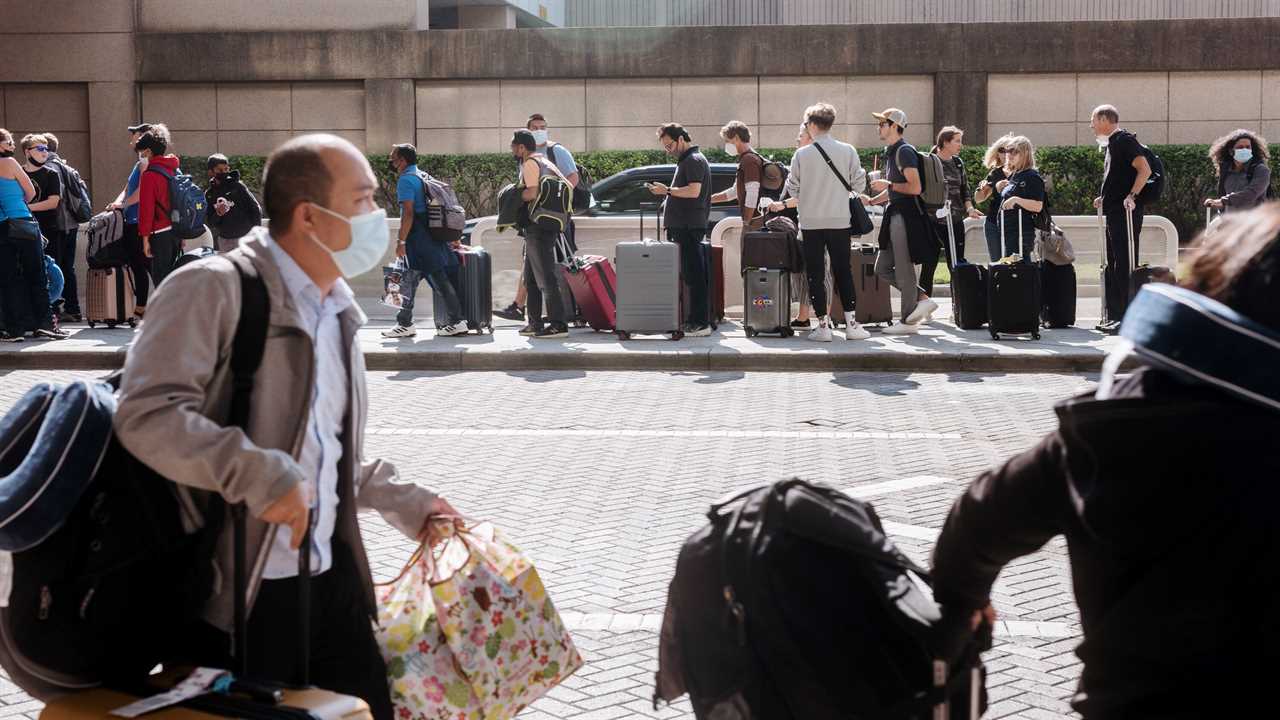
A month ago, Covid-19 cases had begun to rise in a few parts of New England and the Mountain West. But they were still falling in most northern parts of the U.S., as well as in Canada.
That pattern seemed to suggest that a nationwide cold-weather Covid surge was unlikely anytime soon. The prediction models collected by the C.D.C. agreed: They projected continuing declines in U.S. Covid cases during November.
Instead, cases have surged about 30 percent this month.
It is a maddening development. Almost two years after Covid began spreading, it is still here, again creating anxiety as Americans prepare to gather for the holidays. Today’s newsletter will try to help you make sense of the pre-Thanksgiving surge.
The mystery of Covid
The seemingly obvious explanation for the recent rise in cases is the weather. As temperatures have dropped, more activities have moved indoors, where the Covid virus tends to spread. And the weather surely plays some role in the surge.
But I mentioned Canada above — along with the cold-weather parts of the U.S. where caseloads were not rising a month ago — for a reason. If the weather were really the dominant cause, the recent Covid patterns would look different. They would more closely match temperature patterns.
As unsatisfying as this is, the full explanation for the surge remains unclear. There is still much more that scientists do not know about how this virus spreads than they do know, as Michael Osterholm, a University of Minnesota epidemiologist, has been saying for months.
Media coverage and expert commentary too often fails to acknowledge this point. We offer tidy explanations for the virus’s ups and downs — like weather, school calendars, mask habits, even sporting events — when reality is messier. (Here are some detailed examples.)
The bad news about the virus’s unpredictability is that surges can sneak up on us: The lack of a Covid increase across most of northern North America a month ago was not as reassuring as it may have seemed.
The good news is that the virus can also surprise in pleasant ways. This winter, cases are not guaranteed to keep rising. Keep in mind that they peaked in early January last winter, before plummeting about 75 percent by late February. In coming weeks, I’d encourage you to ignore most Covid prognostications. Nobody knows what will happen next.
In the meantime, how should you think about the rising number of cases?
Zero point zero
For most people, the vaccines remain remarkably effective at turning Covid into a manageable illness that’s less dangerous than some everyday activities.
The main dividing line is age. In Minnesota, which publishes detailed Covid data, the death rate for fully vaccinated people under 50 during the Delta surge this year was 0.0 per 100,000 — meaning, so few people died that the rate rounds to zero.
Washington State is another place that publishes statistics by age and vaccination status. In its most recent report, Washington did not even include a death rate for fully vaccinated residents under 65. It was too low to be meaningful.
Hospitalization rates are also very low for vaccinated people under 65. In Minnesota during the Delta surge, the average weekly hospitalization rate for vaccinated residents between 18 and 49 was about 1 per 100,000.
To put that in perspective, I looked up data for some other medical problems. During a typical week in the U.S., nearly 3 people per 100,000 visit an emergency room because of a bicycle crash. The rate for vehicle crashes is about 20 per 100,000.
Covid is the threat on many of our minds. But for most people under 65, the virus may present less risk than a car trip to visit relatives this week. “The vaccination, I think, changes everything,” Dustin Johnston, 40, a photographer in Michigan who plans to gather with family, told The Times.
In need of protection
The situation is more frightening for older people, especially those in their 80s and 90s. For the oldest age groups, Covid presents a real risk even after vaccination. It appears to be more dangerous than a typical flu and much more dangerous than time spent riding in a vehicle, based on C.D.C. data.
As a result, older Americans need protection during a surge. (The same is also true of a small percentage of younger people with specific vulnerabilities to Covid, like organ-transplant recipients.) The most effective way to protect vulnerable people is through vaccination — not only of them but also of others who might infect them.
Children 5 and older, who are now eligible for vaccines, are an example. Covid remains overwhelmingly mild for them. But vaccinated children are less likely to infect other people than unvaccinated children, and a mild Covid case in a child can turn into a deadly case for an elderly grandparent.
The argument for booster shots can be similar. Most younger and middle-aged adults who have received two Covid vaccine shots remain highly protected from severe illness (as these charts show). But the vaccines do seem to wane enough to make people more susceptible to a mild infection they could pass on to a vulnerable person. All Americans age 18 and up are now eligible for booster shots if their most recent shot was at least six month ago.
When discussion of boosters started a few months ago, I was somewhat skeptical, because the evidence of their benefit for most individuals was thin. Their communal value now seems clear, though. I recently got a booster shot, mostly because I will be spending time with older relatives in the coming weeks. The case for booster shots among people over 65 is even stronger.
If you’re anxious about the risks of your Thanksgiving gathering to older people, I’d offer three pieces of advice. One, insist that anybody in your house be fully vaccinated if eligible. Two, encourage people to get tested — either at a testing center or with an at-home rapid test — before coming. Three, once the day arrives, try to put aside your Covid anxiety and enjoy the holiday.
More on the virus:
More than 90 percent of federal employees in the U.S. got at least one shot before a mandated deadline last night.
“Vaccinated, recovered or dead”: European leaders are taking a tougher stance on mandates and restrictions.
THE LATEST NEWS
Business
President Biden will renominate Jerome Powell as the Federal Reserve chair. He picked Lael Brainard — Elizabeth Warren’s favored candidate — for vice chair. Biden is betting on continuity, The Times’s Neil Irwin explains.
Target stores will no longer open on Thanksgiving, making permanent a pandemic policy.
Thanksgiving will be the biggest test of the airline industry’s resilience since the pandemic began.
Jeff Bezos is donating $100 million to Barack Obama’s foundation.
Politics
The Justice Department will pay $130 million to survivors and families of victims of the 2018 massacre in Parkland, Fla., settling a lawsuit that accused the F.B.I. of failing to properly investigate two tips.
An investigation found “overwhelming evidence” that Andrew Cuomo had sexually harassed numerous women.
Other Big Stories
A Milwaukee man faces five counts of homicide after driving into a Christmas parade in Waukesha, Wis., on Sunday. He already had a police record. Here’s what we know about the victims.
Chun Doo-hwan, South Korea’s most vilified former military dictator, died at 90.
New York City cut ties with a homeless shelter operator weeks after a Times investigation showed that the nonprofit’s C.E.O. made over $1 million a year.
Celebrity reminiscing and a running toilet: Records show Jeffrey Epstein living a mundane existence in jail and spinning deceptions until the very end.
Opinions
The Times rated 16,847 U.S. cities and towns based on restaurants, schools and more. Where should you move?
“As the Golden Gate shuts, the Lone Star beckons.” Farhad Manjoo on California versus Texas.
MORNING READS
Style: South Korean youth are wearing hair curlers in public.
Proper biscuits: At the opening of Britain’s first Popeyes fried chicken.
Mystery: The 1991 murder of a wealthy socialite still grips France.
A Times classic: The best movies to watch on Thanksgiving.
Advice from Wirecutter: Don’t keep all produce in the fridge.
Lives Lived: Robert Bly was a poet and an antiwar leader. He found his greatest fame (and controversy) with the 1990 book “Iron John,” which argued that American men had grown soft. Bly died at 94.
ARTS AND IDEAS
The top books of the year
Whether your literary habits include sci-fi, poetry or nonfiction, The Times Book Review’s annual roundup of 100 notable books includes options for you. “We whittled down an initial list of something like 500 books,” Gregory Cowles, who helped edit the project, said. It includes works by Chang-rae Lee, Sally Rooney, Kazuo Ishiguro, Colson Whitehead, Jonathan Franzen and more:
Fiction: “Strange Beasts of China,” by Yan Ge, is an enchanting novel about a cryptozoologist pursuing fabled creatures.
Memoir: “Somebody’s Daughter,” by Ashley C. Ford, begins with a phone call in which the author learns that her father is coming home after almost 30 years in prison.
Nonfiction: “A Little Devil in America: Notes in Praise of Black Performance,” by Hanif Abdurraqib, makes powerful observations about race through music, television, film, minstrel shows and vaudeville.
Stories: “Afterparties,” by Anthony Veasna So, is a deeply personal, frankly funny and illuminating debut, published eight months after the author’s death at 28.
PLAY, WATCH, EAT
What to Cook
Make sheet-pan chicken chilaquiles.
Two Days to Thanksgiving
Don’t fear the bird: Padma Lakshmi shared her recipe for slow-roasted turkey with apple gravy. And Melissa Clark has the absolute best pumpkin, apple and pecan pies.
What to Watch
Paul Thomas Anderson’s new film “Licorice Pizza” is a love story set in California’s San Fernando Valley in the 1970s.
What to Read
She’s the “Julia Child of the soybean circuit”: Fifty years ago, Frances Moore Lappé spurred a movement toward vegetarianism with “Diet for a Small Planet.”
Late Night
The hosts celebrated Biden’s 79th birthday.
Now Time to Play
The pangram from yesterday’s Spelling Bee was function. Here is today’s puzzle — or you can play online.
Here’s today’s Mini Crossword, and a clue: Consumed eagerly (five letters).
If you’re in the mood to play more, find all our games here.
Thanks for spending part of your morning with The Times. See you tomorrow. — David
P.S. Here’s why Times journalists don’t vote for sports M.V.P.s, Tonys or other awards.
Here’s today’s print front page.
“The Daily” is about the Claiborne Highway. On “The Ezra Klein Show,” the sociologist Patrick Sharkey talks about public safety beyond policing.
Claire Moses, Tom Wright-Piersanti, Ashley Wu and Sanam Yar contributed to The Morning. You can reach the team at [email protected].
Sign up here to get this newsletter in your inbox.
Title: The Latest Covid Surge
Sourced From: www.nytimes.com/2021/11/23/briefing/covid-surge-us-thanksgiving-cases.html
Published Date: Tue, 23 Nov 2021 11:24:16 +0000






